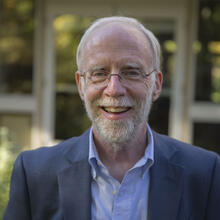Cambridge, MA. This is the last of my Lenten reflections on the second Chapter of the Yoga Sutras, the Yoga of Action, yoga in action. (You can find the preceding entries here.)
We have in the past several weeks been looking at the last part of the chapter, the eight “limbs” — integral but subordinate parts of yoga — and most recently, the sixth and seventh limbs, holding (dharana) one’s attention on a chosen object, and meditating (dhyana), wherein one abides for increasingly longer periods of time in attentive presence to and with some object of meditation. I suggested that this was a perfectly fine practice for Holy Week.
The last of the limbs is samadhi, a state of concentration, “enstasy” (a turning within, rather the opposite dynamic to the also familiar religious state of “ecstasy”) or, as I prefer at the moment, “indrawing” or "indrawal." Even if in the first chapter of the Sutras Patanjali carefully traces a gradual quieting of the mind, the several ever simpler modes of intellectual work that take place, here he speaks rather concisely of this state:
“When meditation shines forth simply as the object, as if empty of proper form, that is indrawal.” (Yoga Sutras III.3)
The meditating person is given over entirely to the object, as if the object alone, radiant and present, were the entirety of the contemplation. If one is open to the connections, and not worried about keeping yoga away from the deepest reaches of Christian prayer, then this is perhaps something of what St. Paul meant in saying, in words perfect for Holy Week, “I have been crucified with Christ; and it is no longer I who live, but it is Christ who lives in me. And the life I now live in the flesh I live by faith in the Son of God, who loved me and gave himself for me.” (Galatians 2.19b-20)
That is, it seems, one no longer stands apart from that upon which one meditates, but simply gives way entirely before its luminous presence, becoming (as it were) that upon which one looks. This is perhaps a kind of farthest reach of the Biblical exhortation, “Be still and know that I am God” (Psalm 46.10). In this state, where holding and meditatinghave become a serene indrawing that gives itself over to that upon which one meditates, there is, Patanjali adds, “the shining forth of wisdom.” (III.5)
This last moment in yogic practice (as meditation, though Patanjali has much to say in rest of the third chapter on the fruits of specific focused meditations; the post-Easter topic for another year) is not necessarily a permanent state, since as with the movements of the body in yoga and the quieting of breathing, one must learn to extend this long moment, holding it in place before returning to our ordinary, more fragmentary consciousness. But luckily, one can keep practicing without any urgent deadline to meet. For the sake of yoga in Lent, it is good that Lent comes back year after year.
But to conclude on another note: I mentioned last week that samadhi refers not only to this yogic state of advancing meditative practice, but also to the state of the yogi at “death,” when the fluctuations and changes of this life give way permanently and irreversibly to full, quiet, luminous, wise attentiveness. By extension, samadhi refers also to the place where this yogi, who is not cremated, is buried. His or her samadhi is a deep state that is like sleep, like death, and yet too a final extending of the meditation.
I write these words on Holy Saturday, just a few hours before the Vigil. Jesus is still in the tomb, dead, descended, not yet risen. It would seem that for the sake of understanding, a deeper understanding, we might consider too that Jesus is asleep, in yogic samadhi, as he lies there in what we call the Holy Sepulcher.
Now one might immediately worry that this makes it seem that Jesus did not really die on the cross, it was all a show; we do not want to move in that direction, to be sure, even if the Easter Churches were not afraid to speak of the Dormition of the Virgin. Perhaps we do not yet understand the real death of the person who is truly alive.
Attention to the stillness of samadhi, a complete giving over of the self to that which is one’s object of meditation, may help us to rethink what death is for the person entirely given over to God: it is not an evil thing (even if one had suffered terribly beforehand), nor a plunge into oblivion (even if there is, as tradition puts it, a descent into hell), or an entirely passive experience, but rather, as Jesus puts it, a putting down and taking up: “For this reason the Father loves me, because I lay down my life in order to take it up again.” (John 10.17)
The samadhi of Jesus in the tomb, awaiting the utterly simple awakening that comes next: resurrection.







